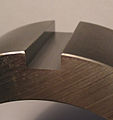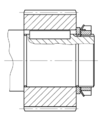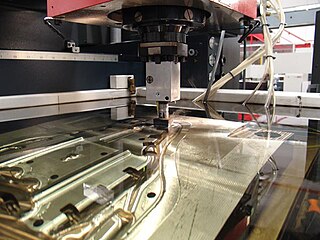Types
There are five main types of keys: sunk, saddle, tangent, round, and spline.
Sunk key
Types of sunk keys: rectangular, square, parallel sunk, gib-head, feather, and Woodruff.
Parallel keys
Parallel keys are the most widely used. They have a square or rectangular cross-section. Square keys are used for smaller shafts and rectangular faced keys are used for shaft diameters over 6.5 in (170 mm) or when the wall thickness of the mating hub is an issue. Set screws often accompany parallel keys to lock the mating parts into place. [3] The keyway is a longitudinal slot in both the shaft and mating part.
- The keyseat in a shaft for a parallel key
- A sprocket with an internal parallel keyway
- Cross-section of a parallel keyed joint
- W = d/4[ clarification needed ]
- H = 2d/3[ clarification needed ]
where
- W is the key width
- H is the key height
- d is the shaft diameter
Woodruff keys
Woodruff keys are semicircular, fitting partly into a circular segment keyway with the remainder fitting into a longitudinal slot keyway in the mating part. The circular segment can be cut directly by plunge cutting with a circular Woodruff cutter without any reliefs. The main advantage of the Woodruff key is the elimination of milling near shaft shoulders, where stress concentrations, [4] and concentricity would be affected. [3] The latter is particularly important for high speed operation. The more exact fit of the key and keyway also reduces play, and stress concentrations in, and improves the reliability of the key. An additional advantage is a stuck key can be removed from a shaft with a hammer blow, the circular profile will push the key out of the slot, as opposed to a standard key which will need to be pushed axially, or pulled out of its slot. Common applications include machine tools, automotive applications, snowblowers and marine propellers.
This type of key was developed by William N. Woodruff of Hartford Connecticut. In 1888, he was awarded the John Scott Medal by the Franklin Institute for his invention. [5]
- A Woodruff key installed
- A Woodruff key and keyway
- Gear G is positively located on shaft S by Woodruff key N
Tapered keys
The tapered key is tapered only on the side that engages the hub. The keyway in the hub has a taper that matches that of the tapered key. Some taper keys have a gib, or tab, for easy removal during disassembly. The purpose of the taper is to secure the key itself, as well as to firmly engage the shaft to the hub without the need for a set screw. The problem with taper keys is that they can cause the center of the shaft rotation to be slightly off of the mating part. [3] It is different from a tapered shaft lock in that tapered keys have a matching taper on the keyway, while tapered shaft locks do not.
Others
A Scotch key or Dutch key features a circular keyway hole (instead of rectangular), produced by drilling axially into the assembled hub and shaft, with a metal dowel pin serving as the key. If the hole and key are tapered, the key is referred to as a Dutch pin, which is driven in and optionally finished by cutting or grinding flush with the end of the shaft. If a straight Dutch keyway hole is optionally tapped with a thread, then an ordinary screw serves as the threaded Dutch key.
Spring pins are an alternative Dutch key component, instead of solid dowel pins. A spring pin is self-fastening and does not work loose under vibration. Hollow spring pins provide a weaker shear strength than a solid dowel pin, and the strength may be varied by varying the wall thickness. This limited shear strength specification is designed to sustain normal operation, but then give way in the event of excessive shaft torque, thus protecting the rest of the machine from damage.
Introducing an additional bushing component between hub and shaft improves the performance and convenience of keyed joints. Taper-Lock bushings are keyed hub fittings which provide three threaded Dutch keyways and two setscrews as Dutch keys, in addition to the rectangular keyway. The Dutch keyways are threaded only on the alternate hub side or shaft side, with a thread clearance hole form on the opposite side. By simply driving setscrews into selected holes, the hub mechanism conveniently operates to rigidly lock or definitely release from the shaft, without hammering or hub-pulling. Quick-disconnect (QD) bushings work similarly, but place a circular pattern of three unthreaded and three fully threaded holes further out from the shaft axis on a bushing flange, instead of across the bushing-to-hub interface.
A Hirth joint is similar to a spline joint but with the teeth on the end of the shaft instead of on the surface.
Saddle keys
These types of keys are generally attached to the driving member (e.g. shafts). These types of keys have less strength as compared with the sunk keys. These are rarely used keys, to transmit lower power to the driven members (e.g. couplings)
Tangent keys
Tangent keys are used in high-torque heavy-duty applications. What would have been the side of each keyway forms heels against which the key sits, and transfers force compressively. This latter point means that for reversible motion of the shaft, another key along a tangent outwards in the opposing direction is needed. Typically this will be offset by 90° or 180° on the shaft. The key may be wedge, rectangular, or square shaped, but particularly rectangular double-taper keys are used.
Spline key
This type of key uses multiple keyways in the hub to transmit high power.
























